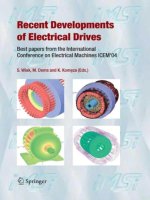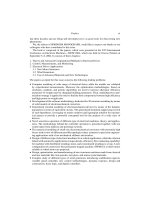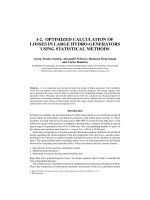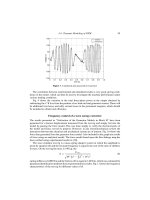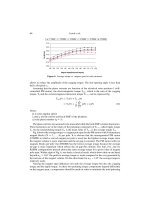Recent Developments of Electrical Drives - Part 36 doc
Bạn đang xem bản rút gọn của tài liệu. Xem và tải ngay bản đầy đủ của tài liệu tại đây (536.92 KB, 10 trang )
III-1.5. RECENT ADVANCES IN
DEVELOPMENT OF THE DIE-CAST
COPPER ROTOR MOTOR
E.F. Brush Jr.
1
, D.T. Peters
2
, J.G. Cowie
2
, M. Doppelbauer
3
and R. Kimmich
3
1
BBF Associates, 68 Gun Club Lane, Weston, MA 02493, USA
2
Copper Development Association Inc., 260 Madison Avenue, New York, NY 10016, USA
,
3
SEW Eurodrive GmbH & Co KG, Ernst-Blickle Str. 42, D-76646 Bruchsal, Germany
,
Abstract. Performanceofseveral motors wherecopperhasbeensubstitutedforaluminumintherotor
squirrel cage is reported. Copper rotor motors die cast in India for agri-pumping were dynamometer
and fieldtested. Copperrotors resulted in higher electrical energy efficiency, slightly higher rotational
speed, lower operating temperature, and higher pumping rates and volume pumped per unit of input
energy. SEW-Eurodrive motors with copper rotors are also described. A 1.1 kW motor with copper
simply substituted and a 5.5 kW motor with redesigned rotor and stator are described. The copper
rotor reduced losses in all major categories. Full-load efficiency was increased 6.7 and 3.1 percent-
age points, respectively. Finally, a study to minimize formation of large pores in die-cast rotors is
summarized.
Introduction
At ICEM 2002, we reported on the performance of motors with die-cast copper rotors.
Rotor I
2
R losses were reduced by 29% to 40% and motor total losses were reduced by
11% to 19% resulting in increased motor efficiencies of no less than 1.5 percentage points.
In this paper, motor test data for another group of motors where copper has been directly
substituted for the aluminum in the rotor are reported. These copper rotors were die cast
in India and motors built and tested by several motor manufacturers there. In the two
years since the last ICEM conference, important advances have been made in designing and
optimizing the rotor andthe entire motorto properlyutilize the higher electrical conductivity
of copper. Ongoing work reported by Kirtley in this conference is showing the importance
of conductor bar shape to accommodate the high electricalconductivity of copperto achieve
high starting torque and to further reduce stray load losses. SEW-Eurodrive in Germany
has made notable advances in design and performance of a series of motors in drives now
commercially available. This paper describes the design approach and test results for 1.1
and 5.5 kW motors optimized for the copper rotor.
S. Wiak, M. Dems, K. Kom
˛
eza (eds.), Recent Developments of Electrical Drives, 349–359.
C
2006 Springer.
350 Brush et al.
Development work on die casting a high melting point metal such as copper has been
reported elsewhere [1,2]. Substantial progress in understanding and managing the porosity
problem characteristic of high pressure die casting has also been made. The results are
applicable to die casting in general and apply to die casting of the rotor in aluminum as well
as copper. This work is summarized here. Together with development of the heated nickel-
base alloy die system to achieve economically attractive die life, this work is significant to
the ability to manufacture the copper rotor.
Motor tests in India
A project to test the suitability of the copper rotor technology upgrade for motors used
for water pumping in agriculture in India was carried out by a cluster of motor and pump
manufacturers at Coimbatore, Tamil Nadu. Copper rotors were cast by a small Indian die-
casting firm for all the tests. Rotor laminations designed for aluminum were used in this
direct substitution evaluation. Motors were built and tested by six motor manufacturers.
Field test of motors fitted to pumps pumping water for agricultural use and one test of a
motor driving a doffing machine in a textile plant were then conducted.
Results for two of the two-pole motors are shown in Tables 1 and 2 and two four-pole
motors in Tables 3 and 4. All of these motors are 415 V, 50 Hz, three-phase. As expected
with a higher conductivity rotor material, the speed is increased slightly, the slip is reduced,
and the efficiency is increased. Starting (locked rotor) torque is also reduced somewhat
when copper is substituted for aluminum in laminations with slots designed for aluminum
as shown inTable 5. Copperrotors generally result in reducedmotor operating temperatures
compared to the aluminum counterpart. This is true in these examples except in the 2-Hp
(1.5 kW) motor where the copper rotor was cast with no cooling fins and the aluminum
counterpart had fins. Even without fins, the motor with the copper rotor ran only about 3
◦
C
warmer than the cooled aluminum rotor motor. The temperature rise data in Table 5 were
obtained by the winding resistance method. Temperature rise by direct measurement of the
core temperature showed the same trends but the temperatures measured were 20
◦
Ctoas
much as 40
◦
C lower.
In addition to the locked rotor torque values reported, the Indian manufacturers of the
four-pole motors of Tables 3 and 4 also reported the pull out (breakdown) torque values.
Here the copper rotors showed improved torque in these particular motors. The 3-Hp (2.2
kW) motor with a copper rotor had a pull out torque of 408.8% of the rated torque compared
to 340.5% for the same motor with an aluminum rotor. Similarly, the 5-Hp (3.7 kW) copper
Table 1. Test results for 2-Hp (1.5 kW), 415-V, two-pole, three-phase, 50-Hz
motor, copper rotor compared to aluminum
Rotor material Load (%) Input power (W) Speed (rpm) Eff. (%)
Copper 100 1,824 2,949 82.54
Aluminum 100 1,856 2,926 81.14
Copper 75 1,440 2,955 79.19
Aluminum 75 1,456 2,940 77.80
III-1.5. Recent Advances in Development of Die-Cast Copper Rotor Motor 351
Table 2. Test results for 5-Hp (3.7 kW), 415-V, two-pole, three-phase, 50-Hz
motor, copper rotor compared to aluminum
Rotor material Load (%) Input power (W) Speed (rpm) Eff. (%)
Copper 100 4,256 2,947 87.09
Aluminum 100 4,496 2,925 83.99
Copper 75 3,232 2,960 85.99
Aluminum 75 3,408 2,935 82.19
Table 3. Test results for 3-Hp (2.2 kW), 415-V, four-pole, three-phase,
50-Hz motor, copper rotor compared to aluminum
Rotor material Load (%) Input power (W) Speed (rpm) Eff. (%)
Copper 100 2,600 1,451 85.88
Aluminum 100 2,660 1,411 83.55
Copper 75 1,960 1,465 84.15
Aluminum 75 2,040 1,433 82.82
Table 4. Test results for 5-Hp (3.7 kW), 415-V, four-pole, three-phase,
50-Hz motor, copper rotor compared to aluminum
Rotor material Load (%) Input power (W) Speed (rpm) Eff. (%)
Copper 100 4,344 1,469 85.97
Aluminum 100 4,544 1,429 83.01
Copper 75 3,280 1,473 85.54
Aluminum 75 3,400 1,443 82.56
Table 5. Locked rotor torque and temperature rise measurements for
two- and four-pole motors, copper rotor compared to aluminum
Rotor Locked rotor torque
Hp Poles material (% of rated torque) Temp. rise (
◦
C)
2 2 Cu 406.2 39.6
1,2
Al 442.2 36.8
1,2
5 2 Cu 174.0 66.7
2
Al 260.9 80.1
2
3 4 Cu 242.4 57.7
Al 268.4 68.8
5 4 Cu 168.4 61.8
Al 205.2 68.9
1
No cooling fins on this die-cast copper rotor.
2
Measured at reduced voltage of 353 V.
352 Brush et al.
Table 6. Field test results of motors of tables 1 and 2 fitted to pumps for
agricultural application
Motor/rotor Input Discharge Energy,
material power, kW V rate, l/s kWh PerkWh
2Hp
Cu 2.413 462 2.43 0.551 3,630
Al 2.171 446 2.01 0.599 3,333
5Hp
Cu 3.86 389 12.93 0.824 12,114
Al 3.77 377 11.71 0.894 11,003
rotor motor had a measured pull out torque of 350.7% of rated torque while the aluminum
version measured 294.2%.
Field testing of three of the motors described above are summarized here. The two-pole
2-Hp (1.5 kW) and 5-Hp (3.7 kW) motors of Tables 1 and 2 were applied to pumping water
for agricultural use. Voltages at many locations in India vary substantially over time.
Table 6 shows that the field voltages were both higher and lower than the nomonal 415
V. But the tests comparing the pumping performance of motors with copper and aluminum
rotors were decisive in terms of pumping time to fill the tanks and energy consumed in
pumping a liter of water. The 2-Hp (1.5 kW) motor-pump combination was tested filling a
2,000 l tank. The tank was brought near to the top in 823 s with the copper rotor motor, 170
s faster than with the aluminum rotor motor, a result of the higher rotational speed of the
copper motor. But importantly, less total energy was consumed even at the higher pumping
rate by the copper motor and the volume of water pumped per kWh was 8.9% higher. The
larger motor was tested filling a 5,000 l tank. Filling time was reduced by 82 s with the
copper motor, i.e., 772 s vs. 854 s. The volume of water pumped per unit of energy was
increased by 10.1% by using copper in the rotor.
It should be noted that the increased speed of a low slip copper rotor motor can be a
problem in pump and fan applications when higher flow rates are not desired. Energy can
be wasted with the aluminum to copper rotor substitution because the power increases with
the cube of the rotational speed to produce the increased flow rate. In the examples above,
the higher flow rate was actually a benefit. If this was not the case, adjustment of the gear
or drive belt ratio could be done to keep the flow rate constant.
The four-pole 5-Hp (3.7 kW) motor of Table 4 was tested in the doffing operation in a
textile plant. At this plant, the available voltage at the time of the tests was about 345 V.
The hourly rate of energy consumption decreased from 1.95 to 1.68 kWh comparing the
aluminum rotor to the copper. This translates to an annual energy savings of 2365 kWh.
Power costs are generally high in India and are $0.109 per kWh at the location of this textile
plant. Annual electricity cost would be reduced by $265.00. The initial cost of the copper
rotor version of the motor was $167.08 which was 10.35% higher than the aluminum rotor
motor. The payback period for the extra investment in the high efficiency copper rotor motor
is only 22 days.
These results generated bymotor manufacturersin India onmotors wheredie-cast copper
has been simply substituted for the aluminum in the rotor with no design modifications
III-1.5. Recent Advances in Development of Die-Cast Copper Rotor Motor 353
support the conclusions for similar material-substituted motors previously reported [3,4].
In thislatest contribution, the severalloss components have not been measured and therefore
there is less information for the designer in attempting to optimize a motor for the high
electrical conductivity of copper. The field tests support the supposition that improved
performance andenergysavingswillresult fromusingimprovedmotorsand that thepayback
period for the moreexpensive motor isvery short.Havingdemonstrated that the copper rotor
consistentlyresultsin increased electrical energyefficiency and loweroperating temperature
and with solutions to the manufacturing and die-casting tool life problems in hand, the
industry is moving on to the problem of design of the motor as a whole and the rotor slots
in particular for copper’s high conductivity.
Sew-Eurodrive experience
SEW-Eurodrive has been active in an extended effort to design the motor to optimally use
copper in the rotor. In April 2003, this company announced the availability of a range of
EFF1 motors. Motors to 50 Hp (37 kW) are now available.The higher efficiency had been
obtained in large part by employing electrical grade copper in the rotor although stator
lamination and winding designs were also modified. These modifications succeeded in
raising efficiency over the entire load spectrum while at the same time maintain torque at
critical points on the torque-load curve including starting torque. This section presents the
major design considerations and results of motor performance tests by IEEE standard 112B
for 1.1 and 5.5 kW motors at both 50 and 60 Hz.
Table 7 presents efficiency data for 1.1 and 5.5 kW SEW aluminum and copper rotor
motors. Comparison of these motors is especially interesting because two different design
concepts have been employed for the 1.1 and the 5.5 kW copper motors. The 1.1 kW motors
essentially have the same layout of stator and rotor laminations. Aluminum rotor bars have
simply been replaced by die-cast copper but the lamination material is of a higher grade.
In contrast the high efficiency DVE132S4 (5.5 kW) has a completely new lamination and
winding design.
The data in Table 7 shows that the copper rotor leadsto asignificant increase inefficiency
whilemaintainingtheoutermotordimensionsstandardfor aluminum—regardlessofdesign.
The advantages of design modifications will became clearer when starting behavior is
discussed below.
Table 7. Full-load efficiencies according to
IEEE 112-B for high efficiency motors
DTE/DVE-series and standard efficiency
motors DT/DV-series
50 Hz 60 Hz
Copper rotor motors
DTE90S4 – 1.1 kW 82.8% 84.1%
DVE132S4 – 5.5 kW 88.1% 89.7%
Aluminum motors
DT90S4 – 1.1 kW 75.7% 77.4%
DV132S4 – 5.5 kW 84.8% 86.6%
354 Brush et al.
Figure 1. Loss distribution at 50 Hz.
In order to evaluate the efficiency contribution of the copper rotor, Fig. 1 shows the
loss distribution for both motor ratings at 50 Hz. Fig. 2 contains the same data for 60 Hz
operation.
The graphs clearly show that the main effects arise from reduced rotor losses. Especially
for the 1.1 kW motor at 50 Hz operation, a decrease of more than 50% in rotor copper losses
was observed. Because of the diagram scaling, the effect for 1.1 kW at 60 Hz does not show
clearly, but indeed a reduction of rotor losses from 39 to 27 W was observed which is a drop
of more than 30%. Since lower losses also lead to decreased operating temperatures, stator
copper losses are also reduced.
A loss component which becomes more and more important with increasing power
ratings are stray load losses (SLL). In Fig. 3 these losses for the motors of this study are
compared. Generally one observes that copper motors have lower SLL than their aluminum
counterparts except for the 1.1-kW/60-Hz measurementwhere the SLL per unit input power
is 0.57% for aluminum and 0.7% for copper. This might be due to a poor correlation in SLL
Figure 2. Loss distribution at 60 Hz.
III-1.5. Recent Advances in Development of Die-Cast Copper Rotor Motor 355
0.0%
0.2%
0.4%
0.6%
0.8%
1.0%
1.2%
1.4%
1.6%
1.8%
Cu 1.1 kW Al 1.1 kW Cu 5.5 kW Al 5.5 kW
SLL / Pin
50 Hz
60 Hz
Figure 3. Stray load loss per input power for 50 and 60 Hz.
estimation. In the aluminum case a correlation coefficient of 0.95 was calculated whereas
all other measurements exhibit a coefficient of about 0.98 to 0.99.
In industrial applications, it is quite common that drives do not run at full load at alltimes.
As a consequence full load efficiencies are not the “one and only” and rather partial load
efficiencies must also be taken into account. For that reason Fig. 4 shows the dependence
of efficiency on output power.
Itcanbestated thateveninthepartialloadregimetheefficiency of thecopperrotormotors
stays above the corresponding standard efficiency aluminum motors. On the other hand, the
efficiency drop for output powers greater than 100% is smaller than it is for aluminum
motors. This is due to the lower temperature rise of the high efficiency motor and therefore
these motors have more thermal reserves which support good overload capabilities.
If aluminum bars are simply substituted by copper bars (the 1.1 kW motors for example,
asmentioned above)the breakdown slip s
k
becomeslowersince s
k
∼R
2
.Focusing onstarting
conditions, this approach leads to decreased starting torque and higher starting current. In
Fig. 5, torque-speed and current-speed curves for both 1.1-kW motors are compared. The
60%
65%
70%
75%
80%
85%
90%
95%
0% 20% 40% 60% 80% 100% 120% 140% 160%
P/Prated
Efficiency [%]
DT90S4
DTE90S4
DV132S4
DVE132S4
Figure 4. Efficiency dependence on output power (50 Hz only).
356 Brush et al.
0
2
4
6
8
10
12
14
16
18
20
0 500 1000 1500
n [min-1]
M [Nm], I [A]
Current Cu
Torque - Al
Current - Al
Torque - Cu
Figure 5. Torque-speed and current-speed curves for 1.1 kW motors. Standard efficiency aluminum
motor (blue); copper high efficiency motor (red).
starting torque of the copper motor is 15% below that of the aluminum motor but well above
two times rated torque. On the other hand, starting current is increased by about 30%. But
the absolute numbers are still controllable and f ar from being critical. For that reason only
minor design changes had been necessary for 1.1 kW motors.
Thesituationisdifferentformotorsofhigherpowerratingwherestartingcurrents become
more and more critical. Therefore a completely new lamination design was developed for
all SEW high efficiency motors above 3 kW. The curves in Fig. 6 display the results for the
5.5-kW motor.
Again the R
2
effectwith lowerbreakdownslip and a steeper torquecurvesis obvious.But
comparing the starting conditions, currents are nearly of the same magnitude, despite the
lower rotor bar resistance. On the other hand the starting torque is approximately 20% lower
but this was indeed a desired effect, since lower, but sufficient starting torque is beneficial
for gear box life. Sufficient, starting torque has a positive effect on gear box lifetime.
0
20
40
60
80
100
120
0 200 400 600 800 1000 1200 1400 1600
n [min-1]
M [Nm], I [A]
Current - Cu
Torque - Al
Current - Al
Torque - Cu
Figure 6. Torque-speed and current-speed curves for 5.5 kW motors. Standard efficiency aluminum
motor (blue); copper high efficiency motor (red).
III-1.5. Recent Advances in Development of Die-Cast Copper Rotor Motor 357
Porosity control in copper die castings
Copper is a very fluid metal and, apart from its high melting temperature, is readily die cast.
High pressure die casting is the most economical process to form the squirrel cage of the
induction motor rotor, but the high entrance rate of liquid metal through the gates generally
results in some trapped air porosity in the casting. Despite the potential for porosity, rotors
tested by motor manufacturers were remarkably easy to balance and stray load losses were
reduced compared to the aluminum rotor. Both factors seemed to indicate the absence of
large pores in the copper cage. Some larger rotors cast later were found to be difficult to
balance and sectioning of the end rings revealed large pores. Porosity was as much as 25%
in some castings and 8 to 10% in others. These findings prompted an investigation of the
origins of the porosity and means to eliminate formation of large pores. This work is fully
described elsewhere [5] and is summarized here.
Flow 3D software using computational fluid dynamics methods was used to simulate
metal flow into the cavity. These were analyzed to identify shot speed—time profiles that
would cause large pores in the end rings or conductor bars and profiles that would eliminate
large pores in favor of uniformally dispersed small pores.
Simulation of the shot profile used incasting many rotors successfullypredicted the large
end ring pores. This baseline shot profile used to die cast many rotors extended the initial
slow plunger speed so that about 10% of the gate end ring was filled before transition to
the fast shot speed and completion of fill. Sections of end rings typical of this baseline shot
profile are shown in Fig. 7. It is noteworthy that the large porosity was always confined to
the end rings. Copper rotors machined to expose the conductor bars revealed only pin hole
porosity in the conductor bars as shown in Fig. 8. The significant result from the model
simulations was the discovery that slow prefill of the die cavity beyond the gates of 40% to
as much as 55% was predicted to be a strategy to consistently eliminate large trapped air
pores in the end rings.
Experimental runs to test the prediction of the modeling were then conducted. The shot
profile was varied so that the speed transition occurred below the gates about half way up
the runner and at prefills of 33% and 55%.
Figure 7. Photographs of sectioned end rings from copper rotors typical of baseline die-casting
conditions.
358 Brush et al.
Figure 8. Photograph of die-cast copper rotor turned on the OD to exposethe conductor bars. Trapped
air bubbles are not seen in the bars but are clearly visible in the end ring.
Figure 9. Photographs of sectioned end rings with 55% prefill. Ejector end ring on left; gate end ring
on right.
Results are shown in the sawed cross sections of Fig. 9 for the 55% prefill. Porosity
was seen to decrease markedly with increasing prefill compared to acceleration before the
metal reaches the gate. Presumably the amount of prefill cannot be increased indefinitely.
Additional experiments to determine the limit would be valuable.
Acknowledgments
The pilot project for producing and laboratory and field testing of copper rotor motors
in the motor and pump manufacturing cluster at Coimbatore, Tamil, India was initiated

